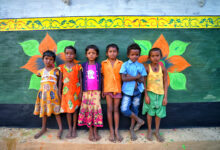In the year 2018, I began to work with artist Partha Dasgupta to document stage by stage his Durga puja pandel creation for the benefit of my research work on Durga pujas of Bengal. Durga Puja is an annual festival of Bengal which pays homage to the Hindu goddess Durga. It is a five days festival in West Bengal, India. The entire city of Kolkata gets decorated around this festival. On the one hand, traditional Hindu classical rituals of worship are performed for Goddess Durga and on the other hand, various clubs turn this puja into a festival.

The most beautiful manifestation of which is through the creativity of various artists which is known as Puja Shilpa(Puja Art) in Kolkata. It is mainly with the financial patronage of the clubs that the artists associated with this art can experiment with new aspects of puja art year after year. My primary motto was to document the entire process of the pandal building not missing out on anything that was related to the constitution.
Artist Partha Dasgupta is a famous ceramic artist, painter, sculptor, art collector in Kolkata. As an artist he has been glorifying the Durga Puja art of Kolkata for several years through his living, breathing installations. The main ingredient of the SB Park (State Bank Park) Durga puja pandal was brick, manufactured in a brick kiln spread over a large area in Roychak on the bank of the Ganges.

For me it was a maiden experience to see the entire process of manufacturing of brick, the staple component for house building. In conversation with Partha Dasgupta, I knew the nitty-gritty of laying bricks during construction of houses. Rat Trap Bond, Flemish Bond and English Bond are some of the example of laying.
The history of brick that highlighted how the civilization of Mesopotamia had given birth to brick and the knowledge of manufacturing it had spread to our country via Egypt, Persia and Indus Valley civilizations. Thousands of bricks were discovered following the excavation of Mohenjo-Daro the main attraction of which is a water tank.

I also gathered information about a city, named Shibam in ancient Turkey. It was built with bricks. The great mosque of Djenne is considered the biggest architecture of mud bricks. I was also introduced to the Brick Romanesque, Brick Renaissance, Brick Gothic forms of architecture.I also came to know of an expressionistic architectural marvel in Germany made of bricks. Named “The Chile House” it was created by architect Fritz Hoger, who used 4.8 million dark Oldenburg bricks for this expressionistic architecture in Hamburg in 1922-1924. Artist Partha Dasgupta made four wooden blocks for manufacturing bricks in a brick kiln at Raichak on the Ganges. The resultant bricks with three different names – SB Park, ১৪২৬(2018), and Sri Durga – embossed on them were meant for building the puja pandal.
The names signified the place, year and occasion to go down in annals of history. More than 70,000 bricks were used to build the entire pandal. Building the furnaces inside the pandal was another important endeavor. That evinced much interest as potteries were given shapes and fired there itself. The main furnace stood at the heart of the pandal. Another six furnaces of smaller kinds were also built inside the pandal Another eight two-brick makeshift furnaces were also built on the two brick walls where clay models were fired with the help of gas burner in a process called Raku.

In this connection I came to know that Raku is a Japanese method of making pottery. Finally, the mouths of the furnaces were opened and the finished potteries became clearly visible to visitors. The terracotta art pieces, used to embellish the pandal were also fired in these furnaces. The entire pandal was an open-air marvel. Inside, it was structured and divided into different zones resembling the architecture of temples of distinction.
First, the visitors would walk down the entry passage crossing the first four furnaces and then come to a free zone face to face with Durga who occupied the largest slot in the middle in front of a 21-feet high wall.














